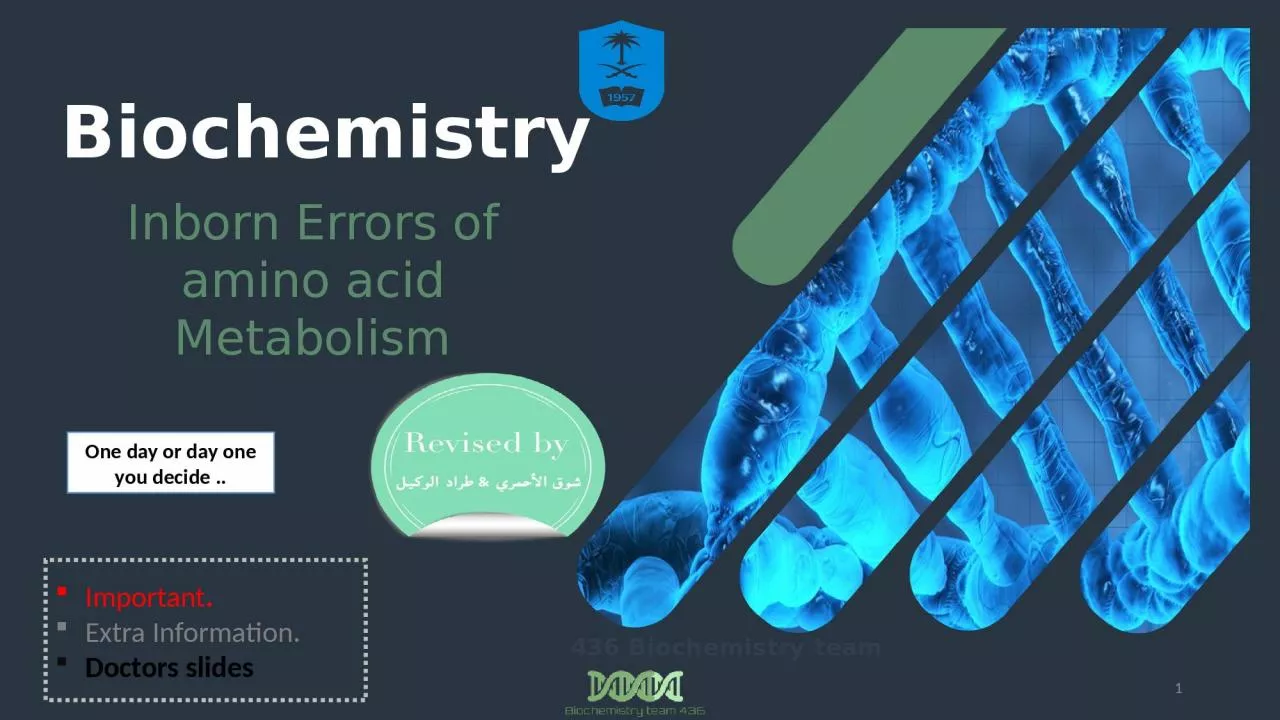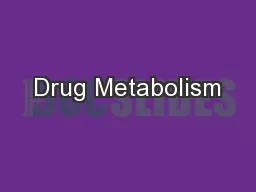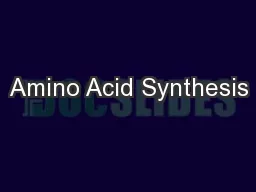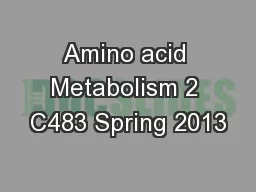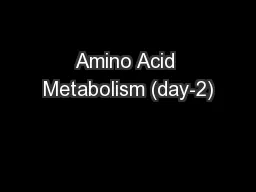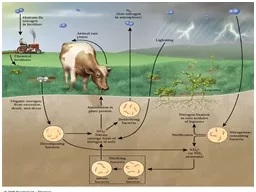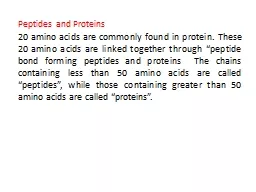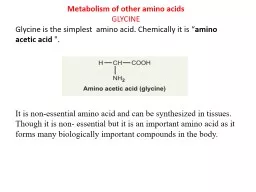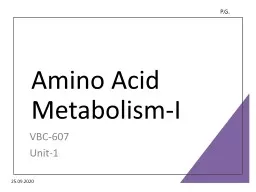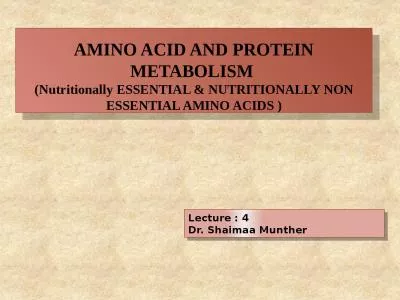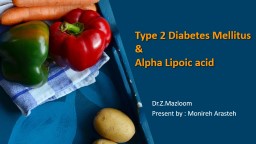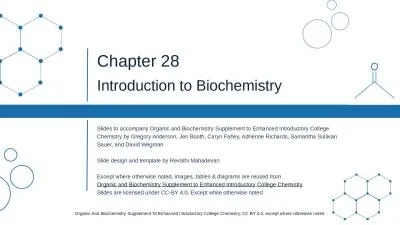PPT-Biochemistry Inborn Errors of amino acid Metabolism
Author : faith | Published Date : 2024-02-09
1 Important Extra Information Doctors slides 436 Biochemistry team One day or day one you decide By the end of this lecture the students will be able to Identify
Presentation Embed Code
Download Presentation
Download Presentation The PPT/PDF document "Biochemistry Inborn Errors of amino acid..." is the property of its rightful owner. Permission is granted to download and print the materials on this website for personal, non-commercial use only, and to display it on your personal computer provided you do not modify the materials and that you retain all copyright notices contained in the materials. By downloading content from our website, you accept the terms of this agreement.
Biochemistry Inborn Errors of amino acid Metabolism: Transcript
1 Important Extra Information Doctors slides 436 Biochemistry team One day or day one you decide By the end of this lecture the students will be able to Identify the amino acid degradation and synthesis of nonessential amino acids. . Cytochrome C in Humans Compared to Other Species Using Bioinformatics. We live in a human-centric world.. Human Metabolism. Sugar +. O. xygen. Energy!. Aerobic respiration. 1. Glycolysis. 2. Citric acid cycle. 15 . Slides. AMINO ACID . CATABOLISM. fig 18-1. fate of amino nitrogen in mammals. fig 18-2. metabolism of amino nitrogen in liver. fig 18-2. nitrogen removal molecules…. fig 18-2. metabolism of amino nitrogen in liver. METABOLISM OR BIOTRANSFORMATION . The conversion from one chemical form of a substance to another. . The term metabolism is commonly used probably because products of drug transformation are called . Stryer. Short Course, Chapter 31. Nitrogen fixation. Bacteria. Nitrogenase. Costly—16 ATP per N. 2. molecule. Assimilation into Amino Acids. In microorganisms/plants: assimilation of ammonia is key—synthesis of most amino acids. 1. Arginine is biosynthesized from this precursor:. Pyruvate. Oxaloacetate. . a. -. ketoglutarate. 3-phosphoglycerate. 2. A . Roundup Ready plant is one that has been genetically modified so that an enzyme (EPSP synthase) can no longer bind to the active ingredient (. What to Know. What is the Metabolic Fate of Ammonium?. How is Escherichia coli Glutamine Synthetase regulated?. Understand general ways that organisms synthesize amino acids. Know the definition of essential versus nonessential amino acids. Approximately 75% are reutilized.. The excess nitrogen forms urea.. Proteins represent 10-15 % of total energy supply.. Digestion and Absorption of Proteins.. The . α. -amino group of many amino acids is transferred to . Peptide bond formation. : . α-carboxyl group of one amino acid (with side chain R1) forms a covalent peptide bond with α-amino group of another amino acid . ( . with the side chain R2) by removal of a molecule of water. The result is : Dipeptide ( i.e. Two amino acids linked by one peptide bond). By the same way, the dipeptide can then forms a second peptide bond with a third amino acid (with side chain R3) to give . GLYCINE. Glycine is the . simplest . amino acid. Chemically it is “. amino acetic acid. . ".. It is non-essential amino acid and can be synthesized in . tissues. . Though it is non- essential but it is an important amino acid as it forms many biologically important compounds in the body.. Unit-1. P.G.. 25.09.2020. Oxidative Deamination . L-AA oxidase and D-AA oxidase act on L-AA and D-AA respectively and oxidatively removes NH. 3. from AA.. Glutamate formed by transamination reactions is deaminated to . 1 PG FOR MD BIOCHEMISTRY AT AIIMS NAGPUR Program Name: MD Biochemistry Duration of the program : 3 years Educational Qualification: MBBS Mode of selection: Entrance examination conducted by AIIMS GOAL (N. utritionally. . Essential & Nutritionally Non Essential Amino . Acids ). Lecture : 4. Dr. . Shaimaa. . Munther. Nutritionally Essential & Nutritionally Non Essential Amino Acids . Introduction: . Dr. . Zohreh. Mazloom. Shiraz University of Medical Sciences. School of Nutrition and Food Sciences Department of Clinical Nutrition. 1. Learning Objectives. General . metabolic disorders . The . resulting nutritional . Slides to accompany Organic and Biochemistry Supplement to Enhanced Introductory College Chemistry by Gregory Anderson, Jen Booth, Caryn Fahey, Adrienne Richards, Samantha Sullivan Sauer, and David Wegman.
Download Document
Here is the link to download the presentation.
"Biochemistry Inborn Errors of amino acid Metabolism"The content belongs to its owner. You may download and print it for personal use, without modification, and keep all copyright notices. By downloading, you agree to these terms.
Related Documents

